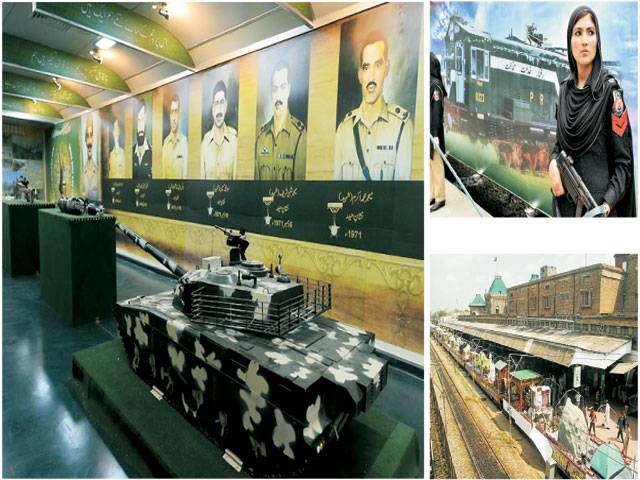Islamabad - As the entire nation is geared up to celebrate the Independence Day on August 14 with national fervour, addition of two bogies this time by the Inter-Services Public Relations (ISPR) in the ‘Azadi Train’ has made it more unique.
The two bogies are depicting different operations, miniature model of missiles and military equipment and Pakistan Movement for Independence.
The special train which left Islamabad yesterday for Peshawar from where it will go to Karachi and Quetta has been decorated with the national flag and posters highlighting culture of country’s federating units.
The Azadi Train has been arranged and decorated by the ministry of railways with the help of the provinces and Pakistan Army.
“This time the decorated Azadi Train highlights more nationalistic values,” said Muhammad Ali Shah, a civil engineer by profession who visited Islamabad Railway station to see off the special train.
Ali was happy to see the addition two special bogies decorated by the ISPR and said this reflects the national will about tackling of the challenge relating to terrorism and role of Armed Forces of Pakistan in eliminating the terrorism from the country.
Pakistan has made significant gains over the past two years through major military operation Zarb-e-Azb against terrorism.
Through the operation Zarb-e-Azb led by Chief of Army Staff General Raheel Sharif, Pakistan has not only successfully broken the back of the terrorists but also established its writ in the regions bordering Afghanistan.
The successes of the Armed Forces against terrorists have been possible with the support of the Pakistani nation and resolve to make the country free of terrorism. The international community has also commended Pakistan’s successful counterterrorism strategy.
Addition of two bogies decorated by the ISPR does reflect the resolve the Armed Forces to tackle any challenge facing the country.
Pakistan’s successes in fight against terror came after huge sacrifices by the people of Pakistan including the security forces.
Pakistan owned the war US-led war against terror in 2008 when Pakistan Army launched first major military operation Rah-e-Nejjat against terrorists in Swat and Malakand.
Based on the lessons drawn from the Swat operation Pakistan Armed Forces planned final push through Zarb-e-Azb which cleared the entire FATA region border Afghanistan, especially the North Waziristan Agency, a place once regarded as epicentre of international terrorism primarily because of the presence of al Qaeda.
The operation Zarb-e-Azb was launched largely with focus on the defunct Tehreek-e-Taliban Pakistan (TTP), a key associate of al Qaeda which has been wiped out from North Waziristan.
Some of the TTP commanders including its Chief Mullah Fazlullah had fled into Afghanistan and trying to destabilise Pakistan through terrorist actions with the help of anti-Pakistan forces.
Earlier, Azadi Train started its journey on Thursday to rejuvenate the sense of patriotism among the people by displaying different aspects of historical struggle for Pakistan, besides culture and civilisation.
The people will be able to witness Pakistan’s journey since 1947 in a few hours through the Azadi Train, it is a joint venture of the Ministry of Information and Pakistan Railways.
Citizens can enjoy the unique experience at the railway stations of their respective cities. A float representing Punjab province consists of models of Quaid-i-Azam Solar Park Bahawalpur, Sahiwal Coal Power Project, Metro Bus and different other models representing Punjab culture.
On Sindh float, there are models of Makli Graveyard, Quaid’s tomb, Sehwan Sharif and different features representing old rich historical background of Sindhi culture.
While, on the Khyber Pakhyunkhwa float, beautiful models of Qissa Khawani Bazaar, Jamrud Fort and other cultural belongings are displayed.
The float belonging to Balochitan are carrying models of Ziarat Residency, Gwadar Port, tribal camps and other objects depicting daily life of people of the province.
The Kashmiri float will include models of Muzaffarabad overhead bridge, Dal Lake’s boat, Hazartbal Shrine and typical houses in Kashmir while the float representing Gilgit-Baltistan (GB) will comprise of K2, Baltit Fort model and other scenic pictures from the area.
According to the report, the main objective of this project is to create awareness about Pakistan’s ideological history and to pay tribute to the national heroes.
Also, there are six galleries in the train that comprise of the pictures about Kashmiris’ struggle and fight for freedom. “It has also been decorated with historical antiques about the history of Pakistan Railways,” it added.






